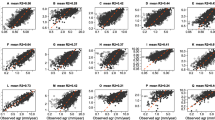Summary
In the Atacama Desert of northern Chile, cacti of the genus Copiapoa occur in extensive, relatively dense, monospecific stands. The spatial distribution patterns within several stands of Copiapoa cinerea v. columna-alba were analyzed for evidence of competitive interactions among individuals. There was no indication that competition was affecting stand density. Mean annual precipitation is only 25 mm/yr, but estimates of maximum possible water use within a stand were much lower. It was shown that the time between rainstorms is long compared to the water storage capacity of the plant stems, especially in the case of small individuals. We conclude that population densities in Copiapoa are limited by the difficulty of establishment, not by competition.
Similar content being viewed by others
References
Anderson, D.J.: Pattern in desert perennials. J. Ecol. 59, 555–560 (1971)
Barbour, M.G.: Age and space distribution of the desert shrub Larrea divaricata. Ecology 50, 679–685 (1969)
Beals, E.W.: Spatial pattern of shrubs on a desert plain in Ethiopia. Ecology 49, 744–746 (1968)
Fonteyn, P.J., Mahall, B.E.: Competition among desert perennials. Nature 275, 544–545 (1978)
Gulmon, S.L., Mooney, H.A.: Spatial and temporal relationships between two desert shrubs, Atriplex hymenelytra and Tidestromia oblongifolia in Death Valley, California. J. Ecol. 65, 831–838 (1977)
Kluge, M., Ting, I.P.: Crassulacean Acid Metabolism, Vol. 30, Ecological Studies. Berlin-Heidelberg-New York: Springer Verlag 1978
Moore, P.D., Bhadresa, R.: Population structure, biomass and pattern in a semi-desert shrub, Zygophyllum eurypterum, in the Turan biosphere reserve of northeastern Iran. J. Appl. Ecol. 15, 837–846 (1978)
Morisita, M.: Estimation of population density by spacing method. Mem. Fac. Sci, Kyushu Univ. E.1, 187–197 (1954)
Pielou, E.C.: A single mechanism to account for regular, random, and aggregated populations. J. Ecol. 48, 575–584 (1960)
Pielou, E.C.: The use of plant-to-neighbor distances for the detection of competition. J. Ecol. 50, 357–367 (1962)
Waisel, Y.: Patterns of distribution of some xerophytic species in the Negev, Israel. Israel J. Bot. 20, 101–110 (1971)
Woodell, S.R.J., Mooney, H.A., Hill, A.J.: The behavior of Larrea divaricata (creosote bush) in response to rainfall in California. J. Ecol. 57, 37–44 (1969)
Yeaton, R.I.: Competition and spacing in plant communities: Differential mortality of white pine (Pinus strobus L.) in a New England woodlot. Amer. Mid. Nat. 100, 285–293 (1978)
Yeaton, R.I., Cody, M.L.: Competition and spacing in plant communities: the northern Mohave Desert. J. Ecol. 64, 689–696 (1976)
Author information
Authors and Affiliations
Rights and permissions
About this article
Cite this article
Gulmon, S.L., Rundel, P.W., Ehleringer, J.R. et al. Spatial relationships and competition in a Chilean desert cactus. Oecologia 44, 40–43 (1979). https://doi.org/10.1007/BF00346395
Received:
Issue Date:
DOI: https://doi.org/10.1007/BF00346395




